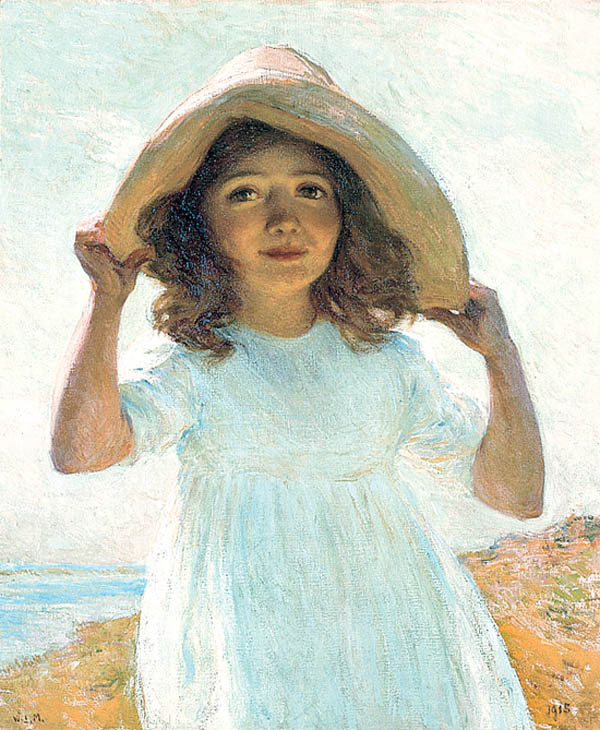American Impressionists Will Highlight Fenimore Art Museum's Summer Season
American Impressionism: Paintings of Light and Life, will be on view at the museum from May 26 to September 16. The exhibition will showcase groundbreaking artists, including Claude Monet, Childe Hassam, William Merritt Chase, Mary Cassatt, Theodore Robinson, John Henry Twachtman, and others. These adaptors of the French Impressionist style revolutionized the American art scene in the late 19th century, and ultimately paved the way to a uniquely American style of painting.
The works in the Fenimore exhibition will be on loan from several sources, including The Arkell Museum (Canajoharie, New York), The Florence Griswold Museum (Old Lyme, Connecticut), The Parrish Museum (Southampton, New York), and The Metropolitan Museum of Art (New York, New York).
Featured in American Impressionism are twenty-six iconic paintings, dating from 1881 to 1920. The works represent nearly every noted American Impressionist from the period. The exhibit will also include Claude Monets Bridge at Dolceacqua (1884), (Sterling and Francine Clark Art Institute) which is an excellent example of French Impressionism that inspired and influenced these American artists. Revered by the American painters included in the exhibition as one of the founders of Impressionist painting in France, Claude Monet was the most prolific practitioner of the movements philosophy of painting outdoors and expressing ones perceptions of nature. Bridge at Dolceacqua dates to the middle of Monets career, following his 1883 move to the village of Giverny. This canvas reflects his twin tendencies during this period to travel in search of compelling subject matter and to paint in series. There are two other paintings that depict nearly identical views of the bridge, and another that takes a longer view of Dolceacqua, the small town on the Italian coast just west of the French border.
Impressionism was a painting style imported to America after the 1880s. The major catalyst was Paris-based art dealer Paul Durand-Ruels 1886 exhibition of French Impressionist paintings in New York City. Comprising nearly 300 paintings by Edgar Degas, Edouard Manet, Claude Monet, and others, the exhibition marked the beginning of serious interest in Impressionist art on behalf not only of American collectors, but also American painters.
Despite the controversy stirred in the press by the avant-garde quality of the works on view, says Megan Holloway Fort, the show was so popular that it was transferred to the National Academy of Design with additional loans from a small group of New York collections and works by Mary Cassatt. Durand-Ruel is reported to have earned some $40,000 from the exhibition, which marked the beginning of serious interest in Impressionist art on behalf not only of American collectors, but also American painters.
Fort continues, Indeed, the 1886 exhibition acted as a powerful catalyst for American artists, especially those who would come to be known as The Ten-Childe Hassam, John H. Twachtman, Julian Alden Weir, Frank Weston Benson, Joseph Rodefer De Camp, Thomas Dewing, Willard Metcalf, Robert Reid, Edward E. Simmons, Edmund C. Tarbell, and later William Merritt Chase. Almost immediately following the show, and throughout the next decade, nearly all of them underwent significant changes in their work. In general, these artists shifted from an academic style that was controlled, deliberate, crafted in the studio, and marked by an absolute precision of finish, to embrace the expressive brushwork, unfinished paint surface, light high-keyed palette, informal compositions, and plein-air technique that are the hallmarks of Impressionist painting.
Speaking about the paintings in the exhibition at the Fenimore, Museum President and CEO, Dr. Paul S. DAmbrosio states, "The paint, the color, and the light in these works separated them from anything that had been done in this country before. He adds, They can truly be called some of the first, modern American paintings."
The artists represented in American Impressionism: Paintings of Light and Life were among the first generation of American painters to utilize the techniques of their French counterparts, such as a brighter palette and the use of broken brushwork. While using innovative techniques, they were traditional in their selection of subject matter, seeking out and painting colorful landscapes, beach scenes, urban views, and perspectives of small town life. The artists had a particular interest in the way light could be captured on canvas.
Frederick Childe Hassam (October 17, 1859 - August 27, 1935) was a prolific American Impressionist painter, noted for his urban and coastal scenes. Along with Mary Cassatt and John Henry Twachtman, Hassam was instrumental in promoting Impressionism to American collectors, dealers, and museums. One of the Hassam paintings included in American Impressionism is titled simply, American Elm, (Arkell Hall Foundation.) During his long career Hassam created numerous paintings and etchings that focused on trees in summer landscapes. Though they seem uncomplicated at first glance, his paintings such as American Elm not only document the evolution of his Impressionist style, but they can also be seen as reflections of his lifelong interest in American heritage. The art historian Elizabeth Broun has written that Hassam portrayed elks, elms, and hickories as silent guardians of America's origin myth. For example, the American Elm, native to the eastern United States, is an extremely hardy tree that can live for several hundred years. Since elm wood had few uses before the twentieth century, trees were often left standing and continued to grow, even as forestland was cleared for farming or settlement. Hassam's choice to focus on the oldest thing standing - here, the Elm tree - reflects his persistent desire to create links to the past.
The Impressionists believed there was a lot more going on with the play of light on various surfaces than people realized, and that's what they wanted to express in their painting, says DAmbrosio. One of the works by which artist Willard Leroy Metcalf (1858-1925) is represented in the exhibition is his oil on canvas titled Child in Sunlight, on loan from the Florence Griswold Museum. Metcalf was a founding member of the Ten American Painters, the group of artists based primarily in Boston and New York who in the 1890s embraced the expressive brushwork, unfinished paint surface, light high-keyed palette, informal compositions, and plein-air technique that are the hallmarks of Impressionist painting. Like many of his contemporaries, Metcalf received early training in Paris, visited the art colonies in the French countryside, and after returning to the United States spent his career traveling constantly in search of inspiring painting sites. Child in Sunlight is a portrait of the artist's daughter, Rosalind, painted on a bright summers day at Pleasure Beach in Waterford, Connecticut, a frequent summer destination for Metcalf and his family.
American Impressionism: Paintings of Light and Life is sponsored in part by Fenimore Asset Management and Golden Artist Colors.
For more information about the exhibition, visit FenimoreArtMuseum.org or phone (607) 547-1400.
About Fenimore Art Museum
The Fenimore Art Museum, located on Otsego Lake - James Fenimore Coopers Glimmerglass Lake - in historic Cooperstown - features a wide-ranging collection of American art including: folk art; important American 18th- and 19th-century landscape, genre, and portrait paintings; an extensive collection of domestic artifacts; more than 125,000 historical photographs representing the technical developments made in photography and providing extensive visual documentation of the regions unique history; and the renowned Eugene and Clare Thaw Collection of American Indian Art comprising more than 800 art objects representative of a broad geographic range of North American Indian cultures, from the Northwest Coast, Eastern Woodlands, Plains, Southwest, Great Lakes, and Prairie regions. Founded in 1945, the Fenimore Art Museum is NYSHA's showcase museum. FenimoreArtMuseum.org is the website.
Listed in USA Today as one of the top 10 places to see art in small cities, The Fenimore Art Museum offers spectacular art to match its spectacular setting on Otsego Lake in scenic Cooperstown, New York.














